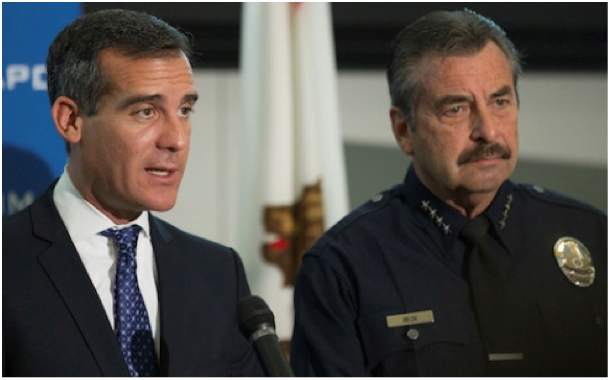Mike Garcia Could Move Mountains
REMEMBERING MIKE GARCIA—One of labor’s great organizers has died. Mike Garcia. These words by SEIU/USWW Local 1877 president David Huerta speak for thousands.
It is with a sad heart today and with Gloria's blessing that I have to deliver the tragic news of the passing of my mentor, my friend, my leader Mike Garcia. After a long fight with diabetes and kidney
failure, Mike is finally at peace.
Mike, to the many he was able to touch through his leadership, was someone who could move mountains through his fight for working people. I will remember him for the lessons he taught me in humility and strength; the heart that it takes to lead and always the need to know what you don't know.
His love for our membership, his community and his family was a driving force in his ability to build one of the most powerful unions in labor. A union built from the blood sweat and tears of immigrant
workers, Black workers and the working poor.
It was his sense of family, community and justice that gave him the clarity by which to lead. There were no gray areas in Mike's fight for justice. His mission was to fight for the least amongst us.
And it was that compassion for working people that made him the man he was.
I will forever be in his debt for giving me the opportunity to be a leader. He opened doors for me and others that had once been closed to him and his generation.
On behalf of the men and women of SEIU/USWW, I want thank Mike Garcia and his family for all that he did and giving us the privilege of having him as our leader. God speed Mike, my brother, my mentor, my president, you will be missed. Be sure to organize a space for all of us in heaven when we get there.
Rest in peace,
Thank you.
Es con un corazón triste hoy y con la bendición de Gloria que tengo que dar la trágica noticia del fallecimiento de mi mentor, mi amigo, mi líder Mike García. Después de una larga lucha con diabetes e insuficiencia renal, Mike finalmente está en paz.
Mike, a los muchos que fue capaz de tocar a través de su liderazgo, era alguien que podía mover las montañas a través de su lucha por los trabajadores. Lo recordaré por las lecciones que me enseñó con humildad y fuerza; El corazón que sabe dirigir y siempre con la necesidad de saber lo que no sabes.
Su amor por nuestra membresía, su comunidad y su familia fue una fuerza impulsora en su capacidad para construir uno de los sindicatos más poderosos del trabajo. Un sindicato construido con el sudor, la sangre y las lágrimas de los trabajadores inmigrantes, los trabajadores de color y los trabajadores pobres.
Fue su sentido de la familia, la comunidad y la justicia lo que le dio la claridad para dirigir. No había áreas grises en la lucha de Mike por la justicia. Su misión era luchar por lo menos entre nosotros. Y fue esa compasión por la gente trabajadora lo que lo convirtió en el hombre que era.
Siempre estaré en deuda con él por darme la oportunidad de ser un líder. Él abrió las puertas para otros y para mí que una vez se habían cerrado a él ya su generación.
En nombre de los hombres y mujeres de SEIU USWW, quiero agradecer a Mike García y su familia por todo lo que hizo y darnos el privilegio de tenerlo como nuestro líder. Dios guardo a Mike, mi hermano, mi mentor, mi presidente, te vamos a extrañar. Asegúrese de organizar un espacio para todos nosotros en el cielo cuando lleguemos allí.
Que descansa en paz
Gracias”
+++
And from another long-time SEIU organizer and political strategist, James Johnson, now the California League of Conservation Voters’ Political Director:
I was so sad to hear of Mike Garcia’s passing.
I had the good fortune to meet this amazing leader 30 years ago when I was a young 22 year old organizer, just starting out on one of my first union assignments in San Diego. One of the first people I met in the labor movement, Garcia was working in San Diego to help organize janitors at the very beginning of the Justice for Janitor movement in California. San Diego in 1985 was a tough and far different place than it is now! Folks were downright anti-union. I was feeling a little homesick but not trying to let on and out of the blue Mike Garcia invited me -- a 22-year old African-American kid from South Los Angeles -- to join him and a couple of veteran organizers for a beer. That extending of a hand meant the world to me. It still does! That was Mike Garcia.
Fifteen years later, and after a number of efforts, Garcia’s union finally succeeded in organizing the janitors at USC where my dad worked for 34 years. My dad’s retired now, having served as a member of the union’s negotiating team. Due to the hard work of members, staff, and leadership of SEIU 1877 and USWW, my dad earned the dignity and respect on the job that our family cherishes.
Mike Garcia was a smart and humble person. I sometimes wished he would run for elective office, but he was first and foremost a union organizer. Like so many of his members I’ve had the honor to work with over the years, he was somebody who thought and spoke passionately about how we make LA work for all of us. I wish everyone had the opportunity to have met Mike Garcia. I know that their lives would have been forever changed. I will miss him.
+++
Finally, a video about Brother Garcia.
(Julie Butcher writes for CityWatch and is a retired union leader now enjoying her new La Crescenta home and her first grandchild. She can be reached at [email protected] or on her new blog ‘The Butcher Shop - No Bones about It.’)
-cw




 It's really an attempt on the part of alarmed people to preserve civilization. The organizers might have called it the March for Civilization and stated the case just as well, but the March for Science is catchy and will draw attention. Let's hope that this isn't confined to big cities on the coasts, and that small town sites of land grant colleges all over the country draw their own crowds.
It's really an attempt on the part of alarmed people to preserve civilization. The organizers might have called it the March for Civilization and stated the case just as well, but the March for Science is catchy and will draw attention. Let's hope that this isn't confined to big cities on the coasts, and that small town sites of land grant colleges all over the country draw their own crowds. 
















 At a press conference on Tuesday, Beck (photo right) said there was a “
At a press conference on Tuesday, Beck (photo right) said there was a “












